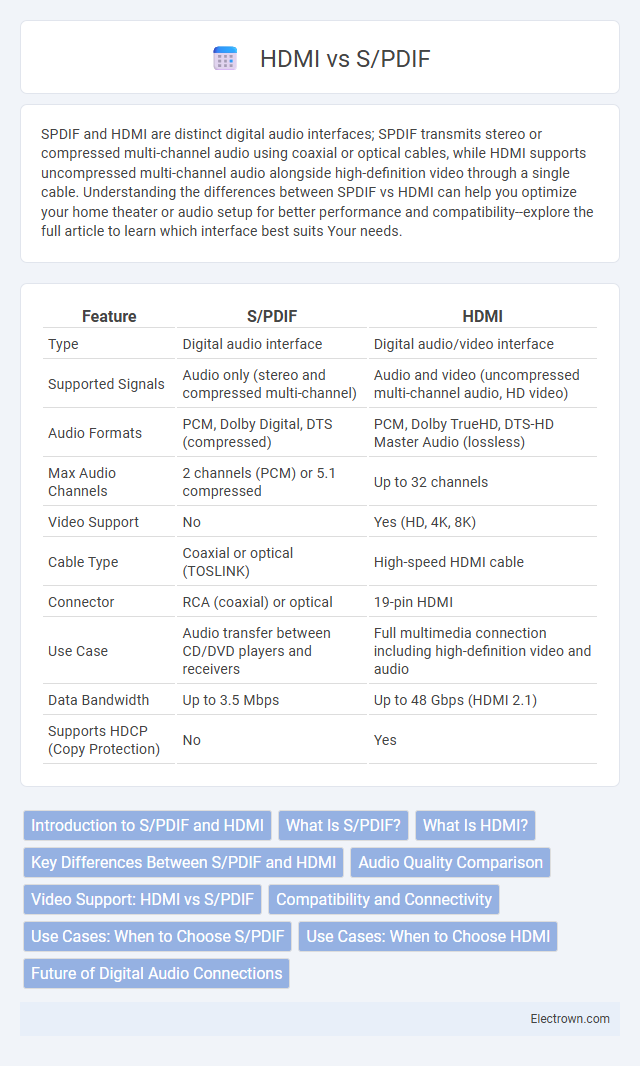SPDIF and HDMI are distinct digital audio interfaces; SPDIF transmits stereo or compressed multi-channel audio using coaxial or optical cables, while HDMI supports uncompressed multi-channel audio alongside high-definition video through a single cable. Understanding the differences between SPDIF vs HDMI can help you optimize your home theater or audio setup for better performance and compatibility--explore the full article to learn which interface best suits Your needs.
Table of Comparison
| Feature | S/PDIF | HDMI |
|---|---|---|
| Type | Digital audio interface | Digital audio/video interface |
| Supported Signals | Audio only (stereo and compressed multi-channel) | Audio and video (uncompressed multi-channel audio, HD video) |
| Audio Formats | PCM, Dolby Digital, DTS (compressed) | PCM, Dolby TrueHD, DTS-HD Master Audio (lossless) |
| Max Audio Channels | 2 channels (PCM) or 5.1 compressed | Up to 32 channels |
| Video Support | No | Yes (HD, 4K, 8K) |
| Cable Type | Coaxial or optical (TOSLINK) | High-speed HDMI cable |
| Connector | RCA (coaxial) or optical | 19-pin HDMI |
| Use Case | Audio transfer between CD/DVD players and receivers | Full multimedia connection including high-definition video and audio |
| Data Bandwidth | Up to 3.5 Mbps | Up to 48 Gbps (HDMI 2.1) |
| Supports HDCP (Copy Protection) | No | Yes |
Introduction to S/PDIF and HDMI
S/PDIF (Sony/Philips Digital Interface) transmits digital audio signals between devices using coaxial or optical cables, primarily supporting stereo audio and limited multi-channel formats. HDMI (High-Definition Multimedia Interface) carries both high-definition video and multi-channel audio, including advanced formats like Dolby TrueHD and DTS-HD Master Audio, over a single cable. Your choice between S/PDIF and HDMI depends on the need for video support and advanced audio quality in your home theater or audio setup.
What Is S/PDIF?
S/PDIF (Sony/Philips Digital Interface) is a digital audio interface used to transmit stereo or multichannel audio signals in a compressed or uncompressed format. It supports formats like LPCM, Dolby Digital, and DTS, typically over coaxial or optical cables, providing a high-quality audio connection between devices such as CD players, receivers, and TVs. Your choice between S/PDIF and HDMI depends on the type of audio data you need to transfer and the compatibility of your equipment.
What Is HDMI?
HDMI (High-Definition Multimedia Interface) is a digital interface that transmits both high-quality audio and video signals through a single cable, supporting high-definition resolution and multi-channel audio formats. It is widely used for connecting devices like TVs, Blu-ray players, gaming consoles, and AV receivers, offering enhanced compatibility and ease of use compared to S/PDIF, which only carries audio signals. Your setup benefits from HDMI's ability to deliver immersive audiovisual experiences without the need for multiple cables.
Key Differences Between S/PDIF and HDMI
S/PDIF (Sony/Philips Digital Interface) transmits uncompressed digital audio signals, primarily supporting stereo sound or compressed multi-channel audio formats like Dolby Digital. HDMI (High-Definition Multimedia Interface) carries both high-definition video and multi-channel audio, including advanced formats such as DTS-HD Master Audio and Dolby TrueHD, making it ideal for modern AV systems. While S/PDIF is limited to audio-only connections with lower bandwidth, HDMI provides a versatile, high-bandwidth solution suitable for comprehensive home theater setups.
Audio Quality Comparison
HDMI supports uncompressed multi-channel audio formats such as Dolby TrueHD and DTS-HD Master Audio, delivering superior sound quality compared to S/PDIF, which is limited to compressed or PCM stereo audio. S/PDIF typically handles up to 5.1 channels in compressed formats like Dolby Digital or DTS but cannot transmit high-resolution audio signals, restricting its fidelity. For audiophiles and high-definition home theater systems, HDMI provides a more robust and immersive audio experience due to its higher bandwidth and support for advanced surround sound technologies.
Video Support: HDMI vs S/PDIF
HDMI supports both high-definition video and audio signals, enabling seamless transmission of uncompressed video formats like 4K and 8K, which S/PDIF cannot handle. S/PDIF is designed exclusively for digital audio transmission and lacks the capability to carry video data. For applications requiring video playback or display, HDMI is the superior choice due to its integrated audiovisual support.
Compatibility and Connectivity
SPDIF offers wide compatibility with older audio equipment through coaxial and optical cables, making it ideal for transmitting stereo or compressed surround sound signals. HDMI supports both high-definition video and multi-channel audio through a single cable, ensuring seamless connectivity with modern TVs, gaming consoles, and AV receivers. Choosing HDMI enhances your setup's versatility by combining audio and video transmission, while SPDIF remains valuable for dedicated audio connections in legacy systems.
Use Cases: When to Choose S/PDIF
S/PDIF is ideal for transmitting high-quality digital audio signals in home theater systems, particularly when connecting older audio equipment like stereo receivers, soundbars, or DACs that lack HDMI ports. This connection supports stereo and compressed surround formats such as Dolby Digital and DTS, making it a reliable choice for audio-only setups without video transmission. You should choose S/PDIF when you prioritize audio clarity and compatibility with legacy devices, rather than the comprehensive audio-video capabilities offered by HDMI.
Use Cases: When to Choose HDMI
HDMI excels in scenarios requiring both high-definition video and multi-channel audio transmission, such as connecting Blu-ray players, gaming consoles, or streaming devices to modern TVs and receivers. Its ability to carry video signals alongside audio makes it ideal for home theater systems and professional AV setups. You should choose HDMI when uninterrupted, high-quality video and audio are essential for your entertainment or presentation needs.
Future of Digital Audio Connections
HDMI supports higher bandwidth and advanced audio formats like Dolby Atmos and DTS:X, making it more future-proof than S/PDIF, which is limited to stereo PCM or compressed surround sound. As multimedia devices increasingly integrate video and audio, HDMI's ability to carry both signals simplifies connections and enhances audio fidelity. Your home theater setup benefits from HDMI's evolving standards, ensuring compatibility with emerging audio technologies and immersive sound experiences.
s/pdif vs hdmi Infographic

 electrown.com
electrown.com